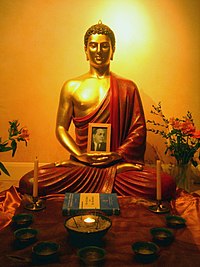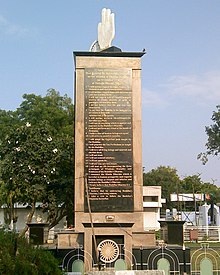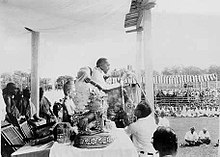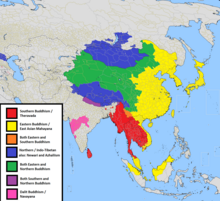Navayana
| Navayāna | |
|---|---|
| नवयान | |
 A Navayāna Buddhist shrine with Ambedkar's portrait and The Buddha and His Dhamma book. The photograph is on the event of the 50th Dhammachakra Pravartan Day. | |
| Type | Dharmic |
| Moderator | Bodhisattva Ambedkar |
| Region | India |
| Founder | B. R. Ambedkar |
| Origin | 1956 Deekshabhoomi, Nagpur, India |
| Members | 7.30 million followers (2011) |
| Part of a series on |
| Buddhism |
|---|
 |

Navayāna (Devanagari: नवयान, IAST: Navayāna, meaning "New Vehicle"), otherwise known as Navayāna Buddhism, refers to the modern re-interpretation of Buddhism founded and developed by the Indian jurist, social reformer, and scholar B. R. Ambedkar;[a] it is otherwise called Neo-Buddhism and Ambedkarite Buddhism.[1][2]
B. R. Ambedkar was an Indian lawyer, politician, and scholar of Buddhism, and the Drafting Chairman of the Constitution of India. He was born in a Dalit (untouchable) family during the colonial era of India, studied abroad, became a Dalit leader, and announced in 1935 his intent to convert from Hinduism to a different religion,[3] an endeavor which took him to study all the major religions of the world in depth, namely Hinduism, Buddhism, Sikhism, Christianity, and Islam, for nearly 21 years.[4][5][3] Thereafter, Ambedkar studied the sacred texts of Buddhism and found several of its core beliefs and doctrines, such as Four Noble Truths and non-self (anātman), as flawed and pessimistic, then re-interpreted these teachings into what he called "New Vehicle" Buddhism, or Navayāna.[6] Ambedkar held a press conference on 13 October 1956, announcing his rejection of Theravāda and Mahāyāna branches of Buddhism, as well as of Hinduism altogether.[7] Thereafter, he left Hinduism and adopted Navayāna Buddhism as his religious faith, about six weeks before his death.[1][6][7] Its adherents see Navayāna Buddhism not as a sect with radically different ideas, but rather as a new social movement founded on the principles of Buddhism.
In the Dalit Buddhist movement, Navayāna is considered an independent new branch of Buddhism native to India, distinct from the traditionally recognized branches of Theravāda, Mahāyāna, and Vajrayāna[8]—considered to be foundational in the Buddhist tradition.[9][b] It radically re-interprets what Buddhism is,[10][c] revising parts of the original teachings of the Buddha to be more concerned with class struggle, social equality, and right to education, taking into account modern problems.[6][11][12]
While the term Navayāna is most commonly used in reference to the movement that Ambedkar founded in India, it is also (more rarely) used in a different sense, to refer to Westernized forms of Buddhism.[13] Ambedkar called his version of Buddhism "Navayāna" or "Neo-Buddhism".[14] His book, The Buddha and His Dhamma is the holy book of Navayāna Buddhism. The followers of Navayāna Buddhism are generally called "Buddhists" (Bauddha) as well as Ambedkarite Buddhists, Neo-Buddhists, and rarely Navayana Buddhists.[15] Almost 90% of Navayāna Buddhists live in Maharashtra.
Origins
[edit]
Ambedkar was an Indian leader influential during the colonial era and the early post-independence period of India. He was the fourteenth child in an impoverished Maharashtra Schedule caste family, who studied abroad, returned to India in the 1920s and joined the political movement. His focus was social and political rights for the Depressed class community.[16] To free his community from religious prejudice, he concluded that they must leave Hinduism and convert to a different religion. He chose Buddhism in the form of Navayana.[16][11]
Doctrines and concepts
[edit]In 1935, during his disagreements with Mahatma Gandhi, Ambedkar announced his intent to convert from Hinduism to Buddhism.[3] Over the next two decades, Ambedkar studied Buddhist texts and wrote The Buddha and His Dhamma which is the primary doctrine of those who follow Navayana Buddhism.[17]
Ambedkar's 22 vows
[edit]
The Twenty-two vows or twenty-two pledges are the 22 Buddhist vows administered by B. R. Ambedkar, the revivalist of Buddhism in India, to his followers. On converting to Buddhism, Ambedkar made 22 vows, and asked his 400,000 supporters to do the same.[18] After receiving lay ordination, Ambedkar gave dhamma diksha to his followers. This ceremony organised on 14 October 1956 in Nagpur included 22 vows administered to all new converts after Three Jewels and Five Precepts. On 16 October 1956, Ambedkar performed another mass religious conversion ceremony at Chandrapur.[19]
It is believed by Ambedkarite Buddhists that these vows are the guidelines of the social revolution that motivates human instincts. These vows demonstrate both the social movement aspect of Navayana Buddhism, and demonstrate its core deviation from earlier sects of Buddhism. In India, these vows are taken as an oath by individuals or groups of people when they convert to Buddhism.[20][21]Commencement
[edit]
Ambedkar re-interpreted Buddhism to address such issues in his mind, and re-formulated the traditional teachings of Buddhism into a "new vehicle" called Navayana.[1][6] Navayana dhamma doctrine as propounded by Ambedkar, states Sumant (2004),[22] "does not situate morality in a transcendental [religious] domain", nor in "a civil association, including the state". Dhamma is derived from and the guiding principle for social conscience.[22]
Navayana Buddhism began in 1956, when Bhimrao R. Ambedkar adopted it, and 380,000 Dalit community members converted to Navayana from Hinduism on 14 and 15 October 1956.[16][7] After that on every year 14 October is celebrated as Dhammachakra Pravartan Day at Dikshabhoomi, Nagpur:
I will accept and follow the teachings of Buddha. I will keep my people away from the different opinions of Hinayana and Mahayana, two religious orders. Our Buddhism is a Neo-Buddhism, Navayana. — B.R. Ambedkar[23]
Scripture and practice
[edit]The writings of Dr. B.R. Ambedkar were posthumously published as The Buddha and His Dhamma, and this is the scripture for those who follow Navayana Buddhism.[24] Among Navayana followers, state Keown & Prebish (2013),[11] this is "often referred to as their 'bible' and its novel interpretation of the Buddhist path commonly constitutes their only source of knowledge on the subject".[11]
Dr. B.R. Ambedkar is regarded as a bodhisattva, the Maitreya, among the Navayana followers.[25][26] In practice, the Navayana followers revere Ambedkar, states Deitrick (2013),[27] as virtually on-par with the Buddha.[27] He is considered as the one prophesied to appear and teach the dhamma after it was forgotten; his iconography is a part of Navayana shrines and he is shown with a halo.[26] Though Ambedkar states Navayana to be atheist, Navayana viharas and shrines features images of the Buddha and Ambedkar, and the followers bow and offer prayers before them in practice.[28] According to Junghare (1988),[29] for the followers of Navayana, Ambedkar has become a deity and is devotionally worshipped.[29][d]
Reception
[edit]Ambedkar's re-interpretation of Buddhism and his formulation of Navayana has attracted admirers and criticism.[12] The Navayana theories restate the core doctrines of Buddhism, according to Zelliot & Macy (1980),[30] wherein Ambedkar's "social emphasis exclude[s] or distort some teaching, fundamental to traditional and canonical Buddhism".[30] Anne Blackburn states that Ambedkar re‑interprets core concepts of Buddhism in class conflict terms, where nirvana is not the aim and end of spiritual pursuits, but a preparation for social action against inequality:
Ambedkar understands the Buddha's teaching that everything is characterized by Dukkha, or unsatisfactoriness, as referring specifically to interpersonal relations. In one instance Ambedkar presents a dialogue in which the Buddha teaches that the root of dukkha is class conflict and asserts elsewhere that "the Buddha's conception of Dukkha is material". — A. Blackburn[12]
Nibbana (Skt. nirvana) the state or process which describes enlightenment, is considered [by Ambedkar] a precursor for moral action in the world and explicitly associated with a non-monastic lifestyle. Nibbana "means enough control over passion so as to enable one to walk on the path of righteousness". Ambedkar's interpretation of dukkha and nibbana implies that moral action, for which nibbana is preparation, will rectify the material suffering of inequality.[12]
Ambedkar considered all ideas in Theravada and Mahayana Buddhism that relate to an individual's merit and spiritual development as insertions into Buddhism, and something that "cannot be accepted to be the word of the Buddha". Buddhism, to Ambedkar, must have been a social reform movement.[12][30] Martin Fuchs states that Ambedkar's effort is to be admired as an attempt to seek a "post-religious religion" which transcends distinctions and as being driven by the "reasonable principle of sociality", not in the sense of spiritual doctrines, philosophical speculations and existentialist questions.[31]
According to Blackburn, "neither view of traditional Buddhism — as a social reform movement or as some other stable entity interpreted (or misinterpreted) from a social reform perspective — is historically accurate", thereby placing Navayana theories to be ahistorical, though it served as an important means for Dalit political mobilization and social movement.[12]
Scholars broadly accept that the depictions of the Buddha as a social reformer are inaccurate.[12][32][e] Gombrich (2012)[33] states that there is no evidence that the Buddha began or pursued social reforms; rather his aim was the salvation of those who joined his monastic order.[33][34][35] Modernist interpreters of Buddhism, states Gombrich, keep picking up this "mistake from western authors", a view that initially came into vogue during the colonial era.[33][36][37]
Richard Gombrich adds that Buddha should not be seen as a social reformer: "his concern was to reform individuals and help them leave society forever, not to reform the world... He never preached against social inequality, only declared it's irrelevance to salvation. He never tried to abolish the caste system nor to do away with slavery"[38]
Empirical evidence outside of India, such as in the Theravada Buddhist monasteries of the Sinhalese society, suggests that class ideas have been prevalent among the sangha monks, and between the Buddhist monks and the laity. In all canonical Buddhist texts, the khattiyas (warrior class) are always mentioned first and never other classes such as brahmans, vessas, suddas.[39]
The novel interpretations and the dismissal of mainstream doctrines of Buddhism by Ambedkar as he formulated Navayana has led some to suggest that Navayana may more properly be called Ambedkarism.[11] However, Ambedkar did not consider himself as the originator of a new Buddhism, but stated that he was merely reviving what was original Buddhism after centuries of "misguided interpretation" by wrong headed Buddhist monks.[11] Others, states Skaria, consider Ambedkar attempting a synthesis of the ideas of modern Karl Marx into the structure of ideas by the ancient Buddha, as Ambedkar worked on essays on both in the final years of his life.[40]
According to Janet Contursi, Ambedkar re-interprets Buddhist religion and with Navayana "speaks through Gautama and politicizes the Buddha philosophy as he theologizes his own political views".[41]
Status in India
[edit]

According to the 2011 Census of India there are 8.4 million Buddhists in India. Navayana Buddhists comprise about 87% (7.3 million) of the Indian Buddhist community, with nearly 90% (6.5 million) of all Navayana Buddhists in India living in Maharashtra state.[42][43] A 2017 IndiaSpend.com report on census data says "Buddhists have a literacy rate of 81.29%, higher than the national average of 72.98%", but it does not distinguish Navayana Buddhists from other Buddhists.[42] When compared to overall literacy rate of Maharashtra state where 80% of Buddhists are found, their literacy rate is 83.17% or slightly higher than statewide average of 82.34%.[42]
According to Jean Darian, the conversion to Buddhism and its growth in India has in part been because of non-religious factors, in particular the political and economic needs of the community as well as the needs of the political leaders and the expanding administrative structure in India.[44] According to Trevor Ling and Steven Axelrod, the intellectual and political side of Navayana Buddhist movement lost traction after the death of Ambedkar.[45]
Festivals
[edit]Major festivals among Navayana Buddhists are:
See also
[edit]- Buddhism in India
- Buddhist modernism
- Buddhist socialism
- Engaged Buddhism
- Humanistic Buddhism
- Marathi Buddhists
Footnotes
[edit]- ^ Bhimrao Ramji Ambedkar is also called Babasaheb Ambedkar.
- ^ ... the Buddhism upon which [Ambedkar] settled and about which he wrote in The Buddha and his Dhamma was, in many respects, unlike any form of Buddhism that had hitherto arisen within the tradition. Gone, for instance, were the doctrines of karma and rebirth, the traditional emphasis on renunciation of the world, the practice of meditation, and the experience of enlightenment. Gone too were any teachings that implied the existence of a trans-empirical realm ... . Most jarring, perhaps—especially among more traditional Buddhists—was the absence of the Four Noble Truths, which Ambedkar regarded as the invention of wrong-headed monks.[9]
- ^ Ambedkar's interpretation of Buddhism was a radical one; it took a revisionist approach to a number of widely accepted traditional Buddhist teachings.[10]
- ^ ... the new literature of the Mahars and their making of the Ambedkar deity for their new religion, Neo-Buddhism. ... Song five is clearly representative of the Mahar community's respect and devotion for Ambedkar. He has become their God and they worship him as the singer sings: 'We worship Bhima, too.' ... In the last song, Dr. Ambedkar is raised from a deity to a supreme deity. He is omnipresent, omnipotent, and omniscient. — Junghare (1988)[29][page needed]
- ^ It has been long recognised that Buddhism and Jainism were not movements for social reform, and that the Buddha's doctrine did not aim at transformation or improvement of the social conditions.[32]
References
[edit]- ^ a b c Tartakov, Gary (2003). Robinson, Rowena (ed.). Religious Conversion in India: Modes, motivations, and meanings. Oxford University Press. pp. 192–213. ISBN 978-0-19-566329-7.
- ^ Queen, Christopher (2015). Emmanuel, Steven M. (ed.). A Companion to Buddhist Philosophy. John Wiley & Sons. pp. 524–525. ISBN 978-1-119-14466-3.
- ^ a b c Dirks, Nicholas B. (2011). Castes of Mind: Colonialism and the making of modern India. Princeton University Press. pp. 267–274. ISBN 978-1-4008-4094-6.
- ^ "Why Ambedkar chose Buddhism over Hinduism, Islam, Christianity". ThePrint. 20 May 2019. Retrieved 19 June 2022.
- ^ "Three reasons why Ambedkar embraced Buddhism". The Indian Express. 14 April 2022. Retrieved 19 June 2022.
- ^ a b c d Zelliot, Eleanor (2015). Jacobsen, Knut A. (ed.). Routledge Handbook of Contemporary India. Taylor & Francis. pp. 13, 361–370. ISBN 978-1-317-40357-9.
- ^ a b c Queen, Christopher (2015). Emmanuel, Steven M. (ed.). A Companion to Buddhist Philosophy. John Wiley & Sons. pp. 524–529. ISBN 978-1-119-14466-3.
- ^ Omvedt, Gail (2003). Buddhism in India: Challenging Brahmanism and caste (3rd ed.). London, UK; New Delhi, IN; Thousand Oaks, CA: Sage. pp. 2, 3–7, 8, 14–15, 19, 240, 266, 271.
- ^ a b Keown, Damien; Prebish, Charles S. (2013). Encyclopedia of Buddhism. Routledge. p. 25. ISBN 978-1-136-98588-1.
- ^ a b Rich, Bruce (2008). To Uphold the World. Penguin Books. p. 204. ISBN 978-0-670-99946-0.[full citation needed]
- ^ a b c d e f Keown, Damien; Prebish, Charles S. (2013). Encyclopedia of Buddhism. Routledge. pp. 24–26. ISBN 978-1-136-98588-1.
- ^ a b c d e f g Blackburn, Anne M. (1993). "Religion, kinship and Buddhism: Ambedkar's vision of a moral community". The Journal of the International Association of Buddhist Studies. 16 (1): 1–22.
- ^ Wiering, Jelle (2 July 2016). ""Others Think I am Airy-fairy": Practicing Navayana Buddhism in a Dutch Secular Climate". Contemporary Buddhism. 17 (2): 369–389. doi:10.1080/14639947.2016.1234751. hdl:11370/5bd3579c-fc6d-45f8-8e69-fa081555ff2a. ISSN 1463-9947. S2CID 151389804.
- ^ Christopher S. Queen (2000). Engaged Buddhism in the West. Wisdom Publications. p. 23. ISBN 978-0-86171-159-8.
- ^ Queen, Christopher (2015). Emmanuel, Steven M. (ed.). A Companion to Buddhist Philosophy. John Wiley & Sons. pp. 524–531. ISBN 978-1-119-14466-3.
- ^ a b c Buswell, Robert E. Jr.; Lopez, Donald S. Jr. (2013). The Princeton Dictionary of Buddhism. Princeton University Press. p. 34. ISBN 978-1-4008-4805-8.
- ^ Queen, Christopher (2015). Steven M. Emmanuel (ed.). A Companion to Buddhist Philosophy. John Wiley & Sons. pp. 529–531. ISBN 978-1-119-14466-3.
- ^ Omvedt 2003, pp. 261–262.
- ^ Jenkins, Laura Dudley (11 April 2019). "Ambedkarite Buddhists: Religious and Political Mobility". Religious Freedom and Mass Conversion in India. University of Pennsylvania Press. pp. 65–66. ISBN 978-0-8122-9600-6.
- ^ "236 dalits adopt Buddhism in protest against Hathras Case". Media India Group. 16 October 2020. Retrieved 24 October 2021.
- ^ Purandare, Vaibhav. "How Babasaheb rejected and criticised the Vedas". The Economic Times. Retrieved 24 October 2021.
- ^ a b Sumant, Yashwant (2004). Jondhale, Surendra; Beltz, Johannes (eds.). Reconstructing the World: B.R. Ambedkar and Buddhism in India. Oxford University Press. pp. 74–75. ISBN 978-0-19-566529-1.
- ^ "press interview at Sham Hotel, Nagpur". Navayan: Homeland of Ambedkarite Buddhism, official website. Nagpur, IN. 13 October 1956. Archived from the original on 8 February 2011.
- ^ Queen, Christopher (2015). Emmanuel, Steven M. (ed.). A Companion to Buddhist Philosophy. John Wiley & Sons. pp. 529–531. ISBN 978-1-119-14466-3.
- ^ Fitzgerald, Timothy (2003). The Ideology of Religious Studies. Oxford University Press. p. 129. ISBN 978-0-19-534715-9.
- ^ a b Bose, M.B. (2017). Kuldova, Tereza; Varghese, Mathew A. (eds.). Urban Utopias: Excess and expulsion in neoliberal south Asia. Springer. pp. 144–146. ISBN 978-3-319-47623-0.
- ^ a b Deitrick, Jim (2013). Keown, Damien; Prebish, Charles S. (eds.). Encyclopedia of Buddhism. Routledge. p. 25. ISBN 978-1-136-98588-1.
- ^ Robinson, Rowena (2003). Religious Conversion in India: Modes, motivations, and meanings. Oxford University Press. ISBN 978-0-19-566329-7.
- ^ a b c Junghare, I.Y. (1988). "Dr. Ambedkar: The hero of the Mahars, ex-untouchables of India". Asian Folklore Studies. 47 (1): 93–121. doi:10.2307/1178254. JSTOR 1178254.
- ^ a b c Zelliot, Eleanor; Macy, Joanna Rogers (1980). "Tradition and innovation in contemporary Indian Buddhism". In Narain, A.K. (ed.). Studies in the History of Buddhism. Delhi, IN: B.R. Publishing. pp. 134–142.
- ^ Fuchs, Martin (2001). "A religion for civil society? Ambedkar's Buddhism, the Dalit issue and the imagination of emergent possibilities". In Dalmia, Vasudha; Malinar, Angelika; Christof, Martin (eds.). Charisma and Canon: Essays on the religious history of the Indian subcontinent. Oxford University Press. pp. 250–273. ISBN 978-01956-545-30.
- ^ a b Krishan, Y. (1986). "Buddhism and the caste system". The Journal of the International Association of Buddhist Studies. 9 (1): 71–84.
- ^ a b c Gombrich, Richard (2012). Buddhist Precept & Practice. Routledge. pp. 344–345, context and discussion: 343–370. ISBN 978-1-136-15623-6.
- ^ Collins, Randall (2000). The Sociology of Philosophies: A global theory of intellectual change. Harvard University Press. pp. 205–206.
- ^ Queen, Christopher S.; King, Sallie B. (1996). Engaged Buddhism: Buddhist Liberation Movements in Asia. State University of New York Press. pp. 17–18. ISBN 978-0-7914-2844-3.
- ^ Alberts, Wanda (2007). Integrative Religious Education in Europe: A study-of-religions approach. Walter de Gruyter. pp. 258–259. ISBN 978-3-11-097134-7.
- ^ Lopez, Donald S. Jr. (2009). Buddhism and Science: A guide for the perplexed. University of Chicago Press. pp. 84–91. ISBN 978-0-226-49324-4.
- ^ Queen, Christopher S.; King, Sallie B. (14 March 1996). Engaged Buddhism: Buddhist Liberation Movements in Asia. ISBN 9780791428443.
- ^ Gombrich, Richard (2012). Buddhist Precept & Practice. Routledge. pp. 343–366. ISBN 978-1-136-15623-6.
- ^ Skaria, A. (201). "Ambedkar, Marx, and the Buddhist question". Journal of South Asian Studies. 38 (3). Taylor & Francis: 450–4655. doi:10.1080/00856401.2015.1049726.
- ^ Contursi, Janet A. (1993). "Political Theology: Text and Practice in a Dalit Panther Community". The Journal of Asian Studies. 52 (2). Cambridge University Press: 320–339. doi:10.2307/2059650. JSTOR 2059650. S2CID 162564306.
- ^ "Manu Moudgil, Dalits are still converting to Buddhism, but at a dwindling rate". The Quint. 17 June 2017.
- ^ Darian, Jean C. (1977). "Social and Economic Factors in the Rise of Buddhism". Sociological Analysis. 38 (3). Oxford University Press: 226–231. doi:10.2307/3709803. JSTOR 3709803.
- ^ Trevor Ling; Steven Axelrod (1980). Buddhist Revival in India: Aspects of the Sociology of Buddhism. Palgrave Macmillan. pp. 49–51. ISBN 978-1-349-16310-6.
Further reading
[edit]- Ambedkar, Bhimrao R. (1950). "Buddha and the Future of His Religion". The Mahä-Bodhi. 58 (4–5): 117–118, 199–20 6.
- Ambedkar, Bhimrao R. (2011). Rathore, Aakash Singh; Verma, Ajay (eds.). The Buddha and his Dhamma: A critical edition. Oxford University Press. ISBN 9780198068679.
- Gannon, Shane P. (2011). "Conversion as a thematic site: Academic representations of Ambedkar's Buddhist turn". Method & Theory in the Study of Religion. 23 (1): 1–28. doi:10.1163/157006811X549670. JSTOR 23555728.
- Jondhale, Surendra; Beltz, Johannes (2004). Reconstructing the world: B.R. Ambedkar and Buddhism in India. New Delhi, IN: Oxford University Press. ISBN 0195665295.
- Singh, Aakash (2011). "The political theology of Navayana Buddhism". In Losonczi, Péter; Luoma-aho, Mika (eds.). The Future of Political Theology: Religious and Theological Perspectives. Farnham, Surrey, UK; Burlington, VT: Ashgate. pp. 159–172. ISBN 9781409417606.
External links
[edit]- van der Velde, P.J.C.L. "The Biography, Navayana as the new Vehicle, and Upaya" (PDF). Psychotherapy and Buddhism. The Netherlands: Radboud University. Archived from the original (PDF) on 5 October 2011.[full citation needed]
- Chung, Byung-Jo (September 2003). "Navayāna Buddhism: A fresh direction for Buddhism to reflect the new millenium". International Journal of Buddhist Thought & Culture. 3. Archived from the original on 19 July 2011 – via eng.buddhapia.com.
